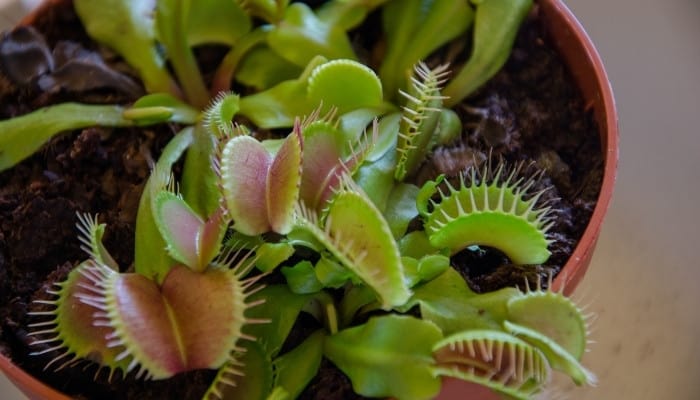Carnivorous plants use various techniques to ensnare their prey, such as pitcher traps, adhesive leaves, and snapping cups that catch unsuspecting insects.
This makes this plant variety extremely interesting.
While you may not be able to purchase a plant that will expect a four-course dinner, typical store-bought varieties are equally interesting to watch as they devour an unsuspecting fly!
What carnivorous plants grow indoors? Carnivorous plants that can be grown indoors include the Venus flytrap, pitcher plant, sundew, butterwort, bladderwort, and monkey cups. These plants adapt to indoor growing conditions fairly well if they are provided with correct heat, light, and watering requirements.
If you are new to the world of carnivorous plants, keep reading to discover the exciting varieties available.
List of Carnivorous Plants That Grow Indoors
With so many different types of carnivorous plants to choose from, it can be a little challenging to decide which ones to pick!
Use our helpful list to determine what plant carnivore best suits your home, lifestyle, and budget.
1. Venus Fly Trap (Dionaea muscipula)
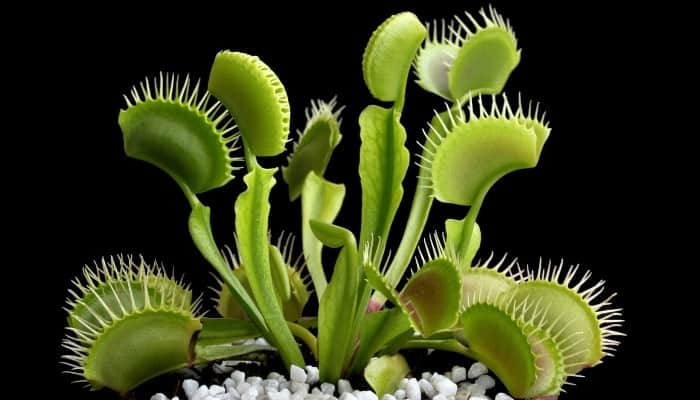
Each petiole of the Venus fly trap ends in a two-hinged lobe, forming its trap.
The inner lobe surfaces are covered in fine trichomes (hairs) that trigger the trap when the prey comes into contact with them.
- Average size: 30 centimeters wide
- Average price: $7-$10
- Key features: Clam-shaped leaves that smell sweet and attract insects when open
- Light requirements: Direct sunlight for at least 6-10 hours per day
- Growing tips: Place in direct sunlight during the growing season and water with rainwater only. Do not fertilize or place in a heated greenhouse.
2. Butterwort (Pinguicula vulgaris)
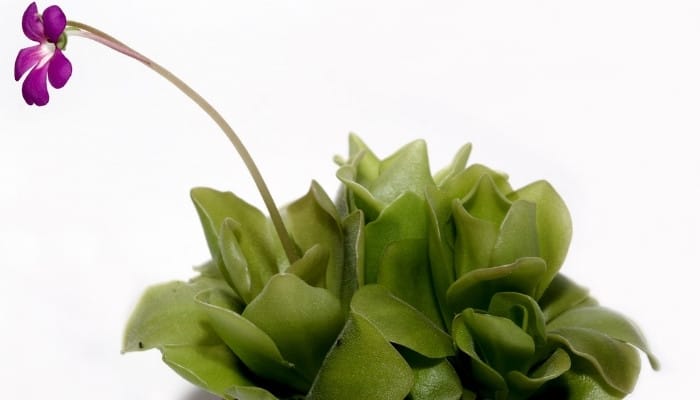
The butterwort produces blue and purple flowers from May to July. The leaves produce a sticky sap to trap insects.
When an insect lands on the plant’s sticky leaves, the leaf edges roll over to digest it.
- Average size: 10-20 centimeters tall
- Average price: $15-$70
- Key features: Flowers appear similar to the violet
- Light requirements: Bright indirect light to prevent leaf scorching
- Growing tips: Stand the plant in a drip tray filled with water to keep the soil constantly moist. Allow the plant to catch its own prey to avoid poisoning the plant or overfeeding.
3. Monkey Cup (Nepenthes spp.)
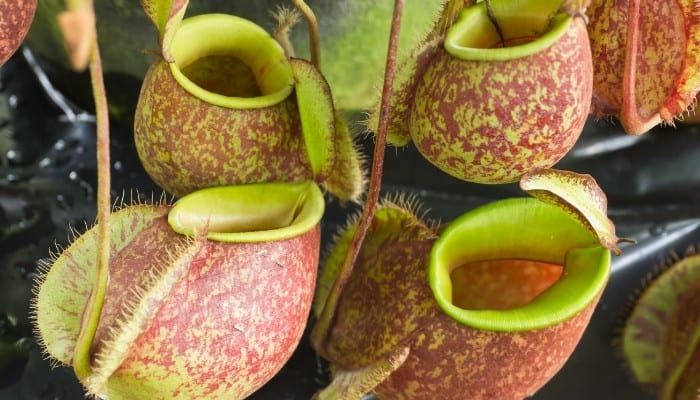
This plant displays reddish dangling pockets similar to cups. These pitchers contain a mild digestive fluid that attracts and dissolves insects.
- Average size: Stems can reach 3 meters depending on the variety.
- Average price: $25
- Key features: Reddish cup-shaped pitchers that dangle from beneath long narrow leaves
- Light requirements: Bright indirect light
- Growing tips: Place the plant in humid areas such as the kitchen or bathroom as low humidity levels will cause the plant to stop producing pitchers.
4. White Trumpet Pitcher Plant (Sarracenia leucophylla)
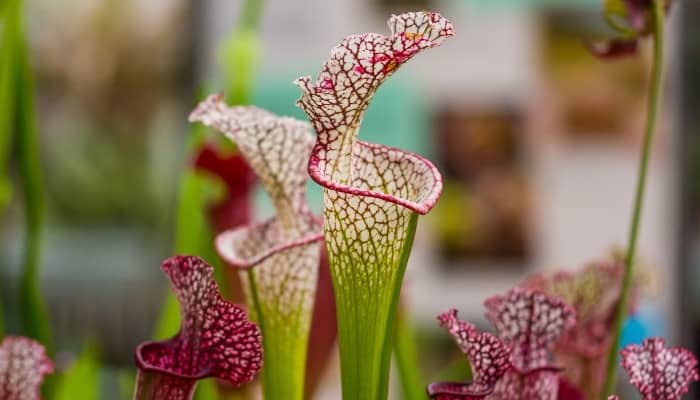
The white-topped pitcher plant has slender green leaves and white cups with red veins towards the frilly tips.
Insects are paralyzed by the nectar and fall into the digestive juices at the bottom of the pitcher.
- Average size: 20-36 inches tall and 40-90 centimeters wide
- Average price: $10-$25
- Key features: Colorful, nectar-producing pitchers that attract insects
- Light requirements: Full sun
- Growing tips: Grow in a soil mixture of sphagnum moss, leaf mold, and grit. Water with rainwater, and keep cool and moist in the winter.
5. Cape Sundew (Drosera capensis)
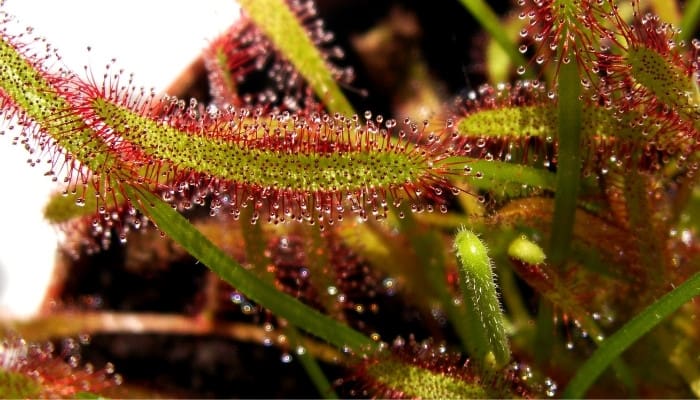
This plant derives its name from the tiny droplets that glisten on its leaves. Each delicate green leaf is covered in fine red hairs or stalks, which secrete a sticky fluid to trap insects.
- Average size: 15 centimeters
- Average price: $7-$36
- Key features: Mobile leaves covered in fine red hairs suffocate and digest insects.
- Light requirements: Bright indirect light
- Growing tips: Keep at room temperature away from drafts, and provide a little humidity by placing it in the bathroom or kitchen for short periods.
6. Australian Pitcher Plant (Cephalotus follicularis)
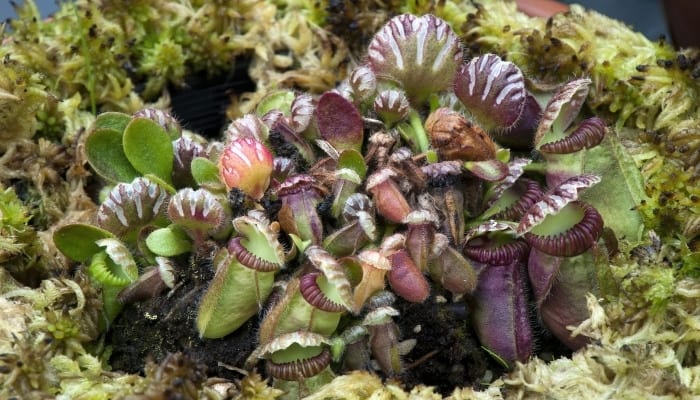
This low-growing variety of pitcher plant produces leaves that are dark red in direct sunshine but remain green in the shade.
The mouth of each pitcher is gruesomely lined with 24 rib-type teeth.
- Average size: Height 0.5-1 meters, width 0.1-0.5 meters
- Average price: $25-$90
- Key features: Insects are digested in the bulb of the pitcher, which contains digestive enzymes.
- Light requirements: Full sun – partial shade
- Growing tips: It enjoys temperatures between 41℉ and 90℉ (5℃ – 32℃). It does not require pruning or fertilizing and prefers moist soil, partial sun, and 60-80% humidity.
7. Purple Pitcher Plant (Sarracenia purpurea)
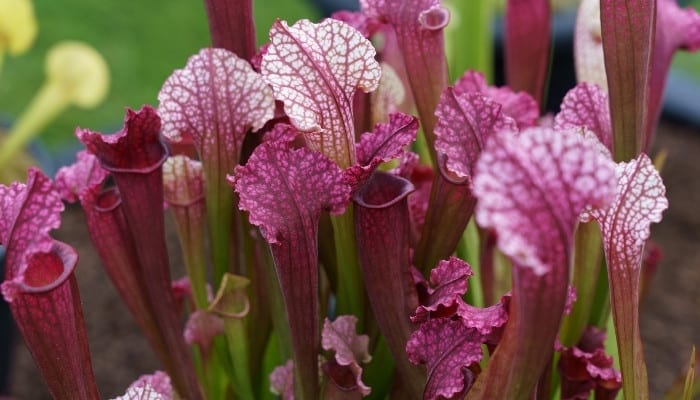
The purple-red pitchers grow close to the ground and collect rainwater. This water is home to tadpoles, mosquito larvae, and bacteria that feast on drowned insects.
Once they have digested the insect, their waste product (poop) provides the nutrients the plant can then absorb easily!
- Average size: 6-inch leaf length
- Average price: $10-$25
- Key features: The plant absorbs nutrients provided by its symbiotic relationship with other microorganisms.
- Light requirements: At least 6-8 hours of bright sunlight per day
- Growing tips: This plant enjoys temperatures of 60-70℉ but can survive in temperatures below 40℉. Place the container on a saucer filled with water to provide constant moisture to the soil and roots.
8. Yellow Pitcher Plant (Sarracenia flava)
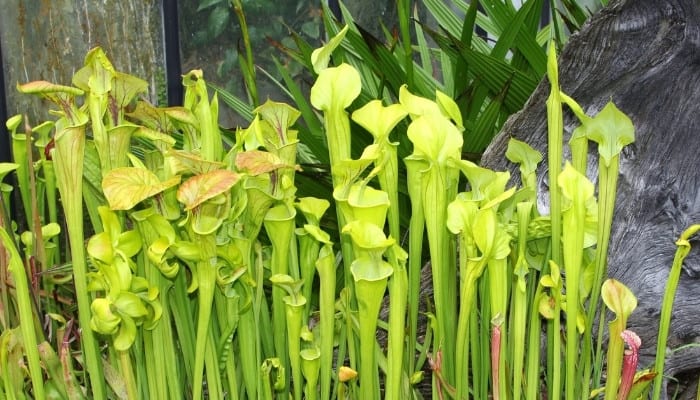
This carnivorous beauty displays yellow-green pitchers with upright lids. Insects landing on the colorful leaves are paralyzed by the nectar.
The insects fall into the pitcher, which contains a digestive enzyme. Once the insect decomposes, the plant absorbs the nutrients.
- Average size: 18-36 inches tall, 17-35 inches wide
- Average price: $8-$25
- Key features: Tall, upright, yellow pitchers with red veining at the pitcher’s throat
- Light requirements: Full sun
- Growing tips: Place in a south- or east-facing window with access to bright sun. Irrigate with rainwater or lime-free water. Protect from cold temperatures as this plant is not frost hardy.
9. Spoonleaf Sundew (Drosera spatulata)

The leaves of the small Spoonleaf Sundew resemble tiny green teaspoons covered in red tentacle-type hairs that secrete a sticky fluid.
Insects stick to this fluid, allowing the plant to start digesting them!
- Average size: 1-3 inches wide
- Average price: $5-$15
- Key features: Leaves resemble teaspoons covered in tiny red hairs that secrete drops of fluid.
- Light requirements: Full sun / partial shade
- Growing tips: Place on a window sill with access to lots of natural light. They also thrive in a greenhouse or terrarium.
10. Bladderworts (Utricularia spp.)

The bladderwort floats beneath the water surface on ponds and lakes. Tiny bladders on the plant roots use water and decompression to suck up unsuspecting prey!
Once the prey is sucked into the bladder, the digestive enzymes dissolve it, and the plant enjoys a healthy snack.
- Average size: 5-8.5 inches wide
- Average price: $20-$50
- Key features: This aquatic plant uses bladders on its roots to absorb unsuspecting insects.
- Light requirements: Full sun for at least four hours
- Growing tips: Indoor bladderwort plants can be grown in equal parts perlite and peat. Place the container over a water-filled drip tray to provide additional moisture.
Care Tips for Indoor Carnivorous Plants
- Keep the soil moist
- Use rainwater/filtered water
- Provide adequate warmth and light
- Move to a cooler position in the heat of the day
- Place the plant in a cool area when dormant
- Do not fertilize
Related Questions:
Can Carnivorous Plants Live Without Bugs?
Carnivorous plants do best on a diet of insects, however, they can absorb nutrients through their leaves and roots and use photosynthesis to survive.
Carnivorous plants grown indoors will benefit from an occasional feeding of small insects.
How Fast Does a Pitcher Plant Grow?
The slow-growing pitcher plant takes 5-10 years to mature. Some species will grow less than 1 inch per year.
Growth can be encouraged by providing ideal growing conditions, including nutrient-poor soil, adequate light, and a proper diet of small insects.
Conclusion
A carnivorous plant lurking on the windowsill certainly adds that zap of wow-factor to every indoor plant setting.
Using the above guide, select the perfect carnivorous plant suited to the plant-monster in you!

